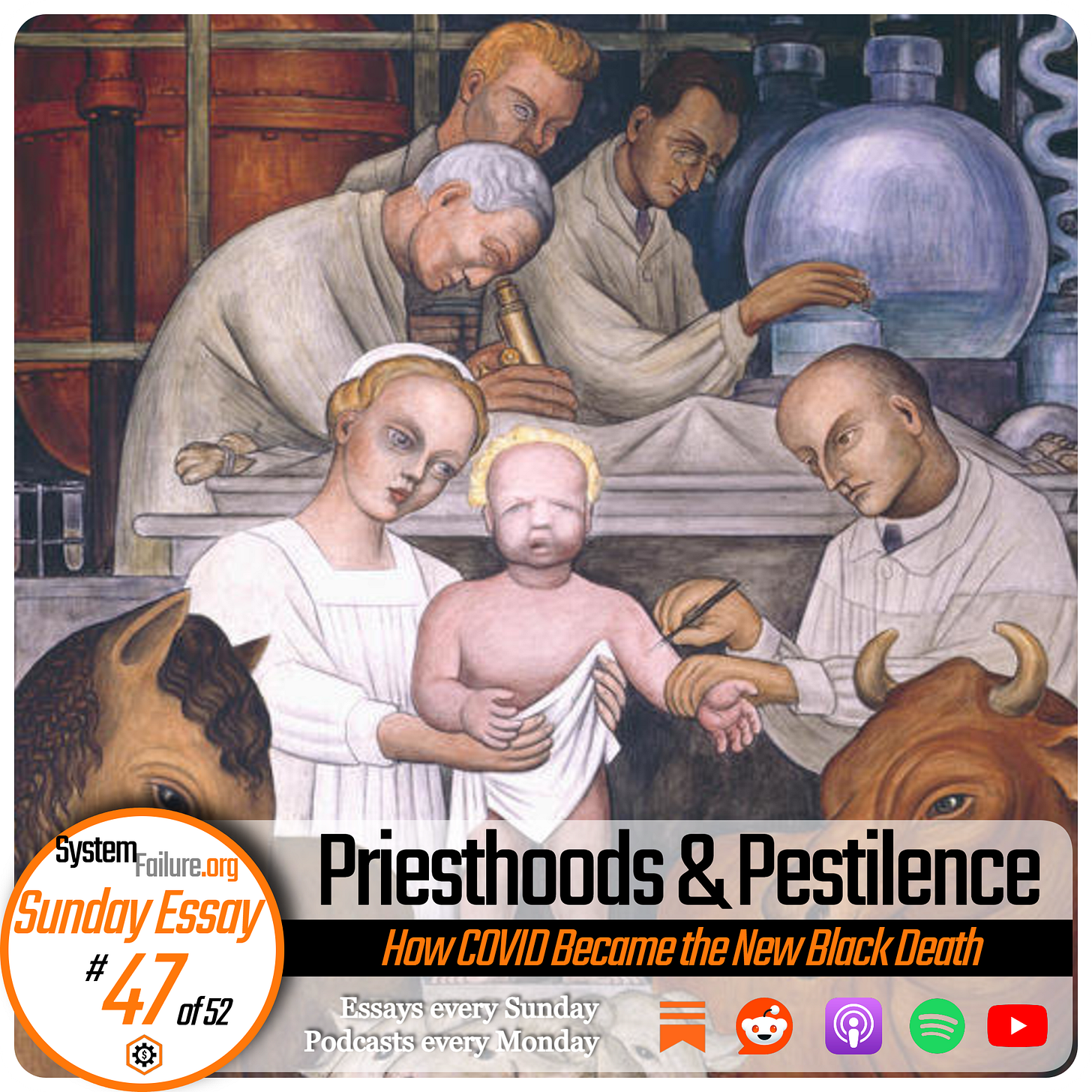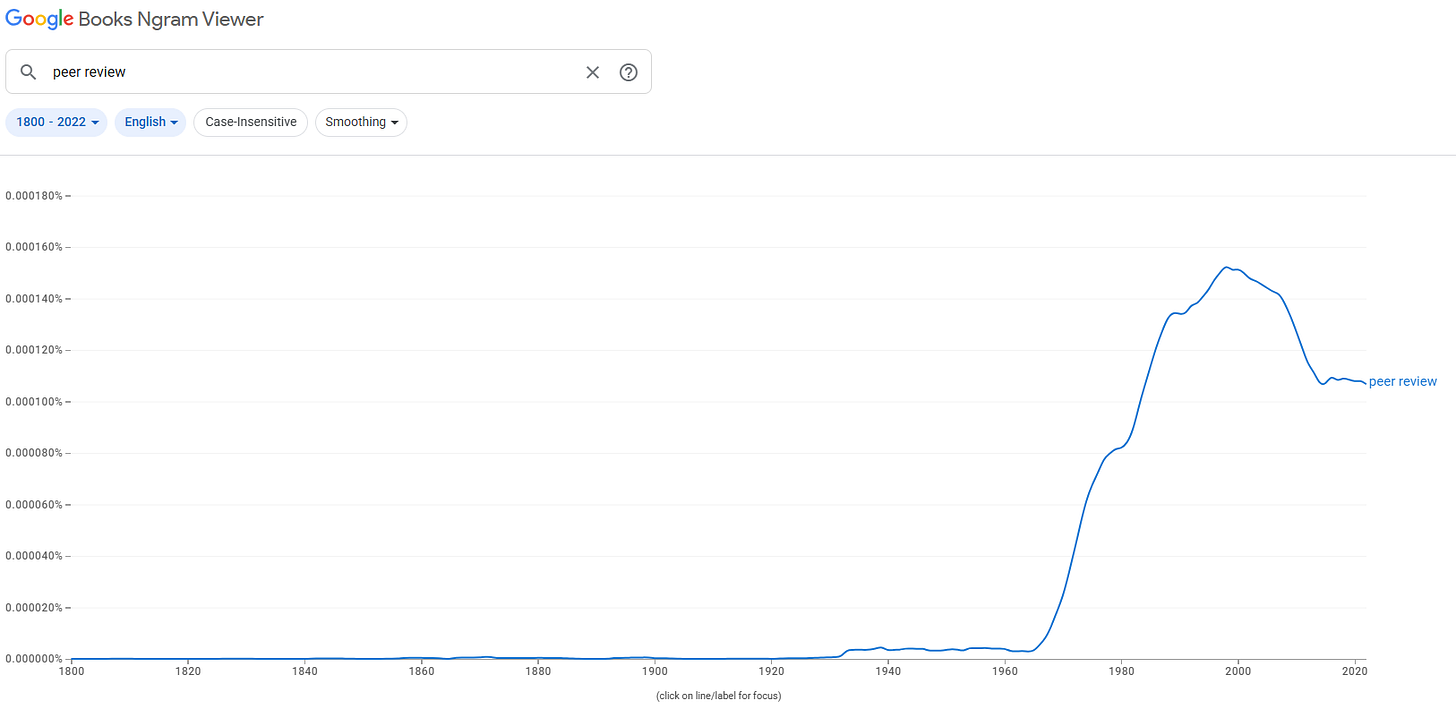Priesthoods & Pestilence
How COVID Became the New Black Death
Key Takeaways:
Like the Church during the Middle Ages, science is today’s reality-defining authority.
The COVID pandemic was similar to the Black Death in that it undermined faith in authority.
The history of “peer review” is a prime example of corruption in the sciences.
Church Authority vs Scientific Authority
The Roman Catholic Church was the authority that defined reality during the Middle Ages. It viciously prosecuted anyone who dared to question its doctrine. Giordano Bruno was a notable heretic who was burned at the stake for his suggestion that stars are other, distant suns. Fear of a similar fate compelled Nicolas Copernicus to wait until his deathbed to publish the theory that the earth revolves around the sun. For corroborating Copernicus’ findings by peering through his new-fangled telescope, the Church placed Galileo under house arrest for life.
But because Copernicus, Galileo, and others like them were ultimately proven correct, the Church forfeited its monopoly on the definition of reality. And once the fallibility of the Church was publicly exposed, the institution of science picked up that fallen mantle of authority.
Today, science defines reality for the general public as the Church once did. The modern priests who separate myth from fact on behalf of the public now wear white lab coats instead of clerical frocks. Heretics are no longer burned at the stake, but those who dare to question science still endure devastating reputational harm. Instead of suffering in the dungeons of the Inquisition, modern heretics suffer from social marginalization and professional disqualification.
A 1933 mural by famed Mexican artist Diego Rivera vividly illustrates the point. He evoked religious iconography by recreating the Madonna-with-child motif that dominated artwork during the Middle Ages. But in his mural, the child is receiving a vaccination shot from a scientist dressed in a white lab coat. Three similarly-garbed wise men populate the background.
Diego Rivera cleverly captured the authoritative parallel between the Medieval Church and modern science with his mural, which serves as the Title Card to this essay. The general public doesn’t conduct experiments. Neither do most of us read peer-reviewed studies. Instead, we take the declarations of the scientific authorities on faith, just as the Medieval public accepted the doctrine of the Roman Catholic Church.
COVID Was The New Black Death
The Black Death played a major role in undermining the credibility of the medieval Church during the late Middle Ages. Not only was the Church exposed as powerless to stop the dying, but priests died in even greater numbers than the laity because their Last Rites duties brought them into disproportionate contact with the pathogen. The Church claimed a monopoly on direct contact with God, but grave doubts about that claim began to fester in the minds of the public after the pandemic.
The recent COVID pandemic exposed our modern scientific authorities in a manner reminiscent of the Church’s exposure during the Black Death. During that time, politicians and corporations borrowed the good name of science to exaggerate claims about the efficacy of mRNA therapy. Strong initial assertions about vaccines preventing transmission turned out to be less-than-accurate.
This co-opting of science was met with at least some resistance. The pre-vaccine Great Barrington Declaration of 2020 shows that it’s not the principles of science that have become corrupt, but rather the institution that has become flawed.
For better or for worse, public skepticism toward scientific authority is on the rise in the aftermath of COVID, just as skepticism toward the Roman Catholic Church took root in the aftermath of the Black Death. Although the COVID pandemic didn’t come with the catastrophic loss of life that made the Black Death one of history’s most terrifying episodes, it did undermine the credibility of the authorities like the plague did back in the 1300s.
The Financial Scam Involved With Peer Review
The notion of peer review is regarded as the gold standard in scientific research. But such was not always the case. From the time of Copernicus and Galileo all the way up until the 1960s, peer review was not the fixture in the sciences that it is today. Google’s ENGRAM viewer—which visualizes the frequency of words or phrases over time by analyzing the text of millions of digitized books—proves the point beyond any doubt:
It was Robert Maxwell who popularized peer review in the early 1960s to sell academic journals. Maxwell owned the Pergamon Press, a publisher of such journals. By normalizing the concept of peer review, he made his academic journals into a guaranteed subscription at every university in the world. Maxwell’s 59 Pergamon academic journals in 1960 ballooned to 418 journals by 1992. He made a fortune on the resulting subscriptions, and that fortune is a big reason why peer review is the gold standard today.
Robert Maxwell was a Jewish Czechoslovakian who managed to escape from the Nazis and spy for the British during World War II. But Maxwell’s true loyalties apparently lay with Israel. His contacts with communist leaders in 1948 were crucial to the Czechoslovakian decision to arm Israel in the Arab–Israeli War. He was rumored to be a Mossad asset, and—after his death in 1991—Maxwell was given a state funeral in Israel.
The most interesting thing about Robert Maxwell, however, is that his daughter is Ghislaine Maxwell, accomplice to noted sex trafficker and financier Jeffrey Epstein. This connection, along with Epstein’s own obsession with science, provides a penetrating insight into a corrupt overlap between high finance, international geopolitics, and the institution of science.
That corruption is similar to the corruption that undermined the reputation of the Roman Catholic Church during the late Middle Ages. As controversy over Jeffrey Epstein swirls in the post-COVID era, we find ourselves in a historical moment eerily reminiscent of the aftermath of the Black Death. Then as now, it’s dawning on the public that trusted authorities have made compromises with the truth to preserve their power and influence.
Conclusion
The point of this essay is not to suggest that science itself is either bad or good. Like the medieval Church, science started out as a plucky, popular rebellion against entrenched, established authority. These institutions defy simple categories like good and evil. Rather, they change over time. Both institutions arose during transition periods between major economic systems. As the slave economy of Rome crumbled, Christianity emerged as a rejection of that cruel economic hierarchy to become the state religion of the Empire in its twilight. And as the feudal system decayed, the scientific revolution swept away Church authority and ultimately replaced it. A great irony of history is that these institutions arose as revolutions against corrupt authorities and became the authorities themselves, only to succumb to corruption over time, just as the old authorities had. If this historical pattern holds, the scientific authorities are due for replacement as the modern capitalist economic system circles the drain. The COVID pandemic provided us with a salient clue that this historical pattern is, indeed, persisting.
Further Materials
Coming from both the left and right, and around the world, we have devoted our careers to protecting people. Current lockdown policies are producing devastating effects on short and long-term public health. The results (to name a few) include lower childhood vaccination rates, worsening cardiovascular disease outcomes, fewer cancer screenings and deteriorating mental health – leading to greater excess mortality in years to come, with the working class and younger members of society carrying the heaviest burden. Keeping students out of school is a grave injustice.
Keeping these measures in place until a vaccine is available will cause irreparable damage, with the underprivileged disproportionately harmed.
Fortunately, our understanding of the virus is growing. We know that vulnerability to death from COVID-19 is more than a thousand-fold higher in the old and infirm than the young. Indeed, for children, COVID-19 is less dangerous than many other harms, including influenza.
As immunity builds in the population, the risk of infection to all – including the vulnerable – falls. We know that all populations will eventually reach herd immunity – i.e. the point at which the rate of new infections is stable – and that this can be assisted by (but is not dependent upon) a vaccine. Our goal should therefore be to minimize mortality and social harm until we reach herd immunity.
Excerpt from The Great Barrington Declaration, October 4, 2020




